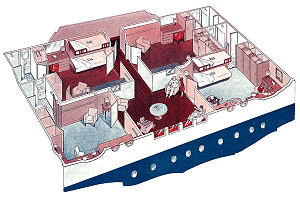
A hull is the watertight body of a ship, boat, submarine, or flying boat. The hull may open at the top, or it may be fully or partially covered with a deck. Atop the deck may be a deckhouse and other superstructures, such as a funnel, derrick, or mast. The line where the hull meets the water surface is called the waterline.

The metacentric height (GM) is a measurement of the initial static stability of a floating body. It is calculated as the distance between the centre of gravity of a ship and its metacentre. A larger metacentric height implies greater initial stability against overturning. The metacentric height also influences the natural period of rolling of a hull, with very large metacentric heights being associated with shorter periods of roll which are uncomfortable for passengers. Hence, a sufficiently, but not excessively, high metacentric height is considered ideal for passenger ships.
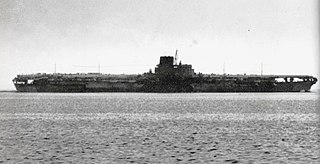
Shinano (信濃) was an aircraft carrier built by the Imperial Japanese Navy (IJN) during World War II, the largest such built up to that time. Laid down in May 1940 as the third of the Yamato-class battleships, Shinano's partially complete hull was ordered to be converted to an aircraft carrier following Japan's disastrous loss of four of its original six fleet carriers at the Battle of Midway in mid-1942. The advanced state of her construction prevented her conversion into a fleet carrier, so the IJN decided to convert her into a carrier that supported other carriers.

The Wayfarer is a wooden or fibreglass hulled fractional Bermuda rigged sailing dinghy of great versatility; used for short 'day boat' trips, longer cruises and for racing. Over 11,000 have been produced as of 2016.

A bulkhead is an upright wall within the hull of a ship, within the fuselage of an airplane, or a car. Other kinds of partition elements within a ship are decks and deckheads.

A cofferdam is an enclosure built within a body of water to allow the enclosed area to be pumped out or drained. This pumping creates a dry working environment so that the work can be carried out safely. Cofferdams are commonly used for construction or repair of permanent dams, oil platforms, bridge piers, etc., built within water.
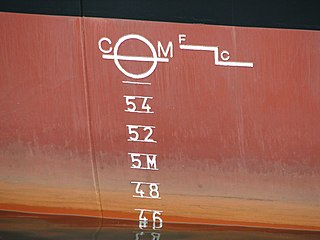
The waterline is the line where the hull of a ship meets the surface of the water. Specifically, it is also the name of a special marking, also known as an international load line or Plimsoll line, that indicates the draft of the ship and the legal limit to which a ship may be loaded for specific water types and temperatures in order to safely maintain buoyancy, particularly with regard to the hazard of waves that may arise. Varying water temperatures will affect a ship's draft, because warm water is less dense than cold water, providing less buoyancy. In the same way, fresh water is less dense than salinated or seawater with a similar lessening effect upon buoyancy.
A double hull is a ship hull design and construction method where the bottom and sides of the ship have two complete layers of watertight hull surface: one outer layer forming the normal hull of the ship, and a second inner hull which is some distance inboard, typically by a few feet, which forms a redundant barrier to seawater in case the outer hull is damaged and leaks.
The strength of ships is a topic of key interest to naval architects and shipbuilders. Ships which are built too strong are heavy, slow, and cost extra money to build and operate since they weigh more, whilst ships which are built too weakly suffer from minor hull damage and in some extreme cases catastrophic failure and sinking.
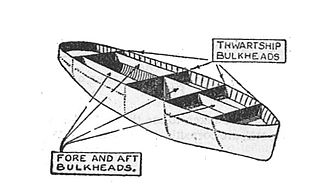
Floodability is the susceptibility of a ship's construction to flooding. It also refers to the ability to intentionally flood certain areas of the hull for damage control purposes, or to increase stability, which is particularly important in combat vessels, which often face the possibility of serious hull breach due to enemy action, and which rely on well-trained damage controlmen to equalize and then stop flooding of the hull.

A ballast tank is a compartment within a boat, ship or other floating structure that holds water, which is used as ballast to provide hydrostatic stability for a vessel, to reduce or control buoyancy, as in a submarine, to correct trim or list, to provide a more even load distribution along the hull to reduce structural hogging or sagging stresses, or to increase draft, as in a semi-submersible vessel or platform, or a SWATH, to improve seakeeping. Using water in a tank provides easier weight adjustment than the stone or iron ballast used in older vessels, and makes it easy for the crew to reduce a vessel's draft when it enters shallower water, by temporarily pumping out ballast. Airships use ballast tanks mainly to control buoyancy and correct trim.

Belt armor is a layer of heavy metal armor plated onto or within the outer hulls of warships, typically on battleships, battlecruisers and cruisers, and aircraft carriers.

The free surface effect is a mechanism which can cause a watercraft to become unstable and capsize.

Ship stability is an area of naval architecture and ship design that deals with how a ship behaves at sea, both in still water and in waves, whether intact or damaged. Stability calculations focus on centers of gravity, centers of buoyancy, the metacenters of vessels, and on how these interact.
Oil tankers generally have from 8 to 12 tanks. Each tank is split into two or three independent compartments by fore-and-aft bulkheads. The tanks are numbered with tank one being the forwardmost. Individual compartments are referred to by the tank number and the athwartships position, such as "one port", "three starboard", or "six center."
SS John P. Gaines was a Liberty ship built during World War II by the Oregon Shipbuilding Corporation, and named for politician John P. Gaines. Northland Transportation Company was chartering the ship from the Maritime Commission and War Shipping Administration that owned the ship as part of the Merchant navy.
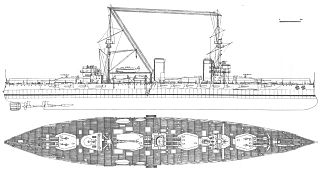
Imperator Nikolai I was a Russian dreadnought built during World War I for service in the Black Sea. She was designed to counter multiple prospective Ottoman dreadnoughts which had been placed under order by the Ottoman government, since this raised the possibility that the Russian dreadnoughts being built for the Black Sea Fleet could be outclassed. The ship used the same main armament as the preceding Imperatritsa Mariya class, but was larger and more heavily armored. Imperator Nikolai I was launched in 1916, but construction was suspended on 24 October 1917. The Soviets considered completing her in 1923, but later rejected the idea. She was towed to Sevastopol in 1927 and scrapped.

Shipwrecking is an event that causes a shipwreck, such as a ship striking something that causes the ship to sink; the stranding of a ship on rocks, land or shoal; poor maintenance, resulting in a lack of seaworthiness; or the destruction of a ship either intentionally or by violent weather.
Longitudinal framing is a method of ship construction in which large, widely spaced transverse frames are used in conjunction with light, closely spaced longitudinal members. This method, Isherwood felt, lent a ship much greater longitudinal strength than in ships built in the traditional method, where a series of closely spaced transverse frames are fitted from the keel to the sheer line, with corresponding deck beams, a method that is well suited to support longitudinal planking.
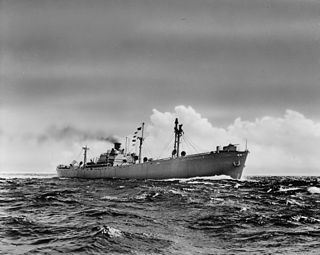
SS William S. Ladd was an American Liberty ship built during World War II, one of the 2,710 type 'EC2-S-C1' ships that carried all kinds and types of dry cargo during the war. She was named for William S. Ladd, an American politician and businessman in Oregon, who twice served as Portland's mayor in the 1850s. The ship's keel was laid on August 29, 1943, and 15 days later, on September 13, the hull was launched. William S. Ladd was fitted out in seven days, and was delivered to the U.S. Navy on September 20. The Navy placed Ladd under charter to Weyerhaeuser Steamship Co.

